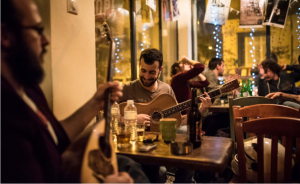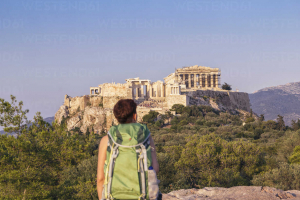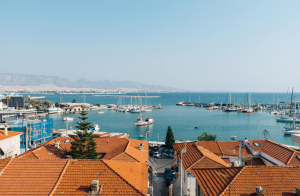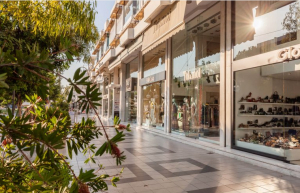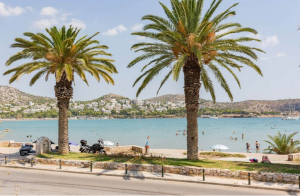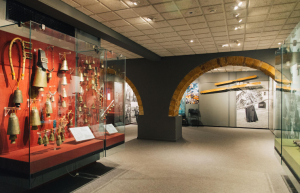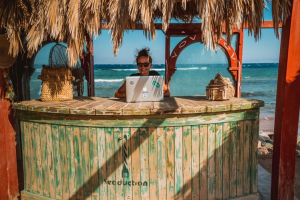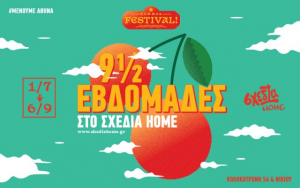ABOUT US
XpatAthens
Athens Unpacked Episode 6 - Songs & Poems
In this fast-tempo episode, we’ll visit a celebrated singer who has worked with some of the greatest Greek composers of the last century, and we’ll unpack some of the city’s most beloved sounds: from the haunting rebetika, born of poverty and catastrophe; to today’s glossy bouzouki nightclubs and the joyous panigiria summer festivals “where all hell breaks loose” in the village and everyone from youngest to oldest joins in the fun.
Thank you This is Athens for your contribution as an XpatAthens Partner.
The Municipality Of Athens & EOT Join Forces
- An ideal year-round city-break destination.
- A standard destination for conferences and large events.
- A top destination for digital nomads.
- A top destination for young travelers, senior travelers, gastronomy lovers, etc.
XpatAthens extends a warm thank you to This Is Athens and the City Of Athens for sharing news and inspiring stories about how Athens aspires to be a clean, friendly, and welcoming city to live in.
Piraeus Neighborhood Guide
Piraeus was first incorporated into Athens in 515 BC. In 493 BC, the great naval strategist Themistocles began fortification works to enclose both cities behind Long Walls. These defences, still visible today, gave the Athenians uninterrupted access to the sea. Over three millennia, Piraeus has grown to become one of the largest passenger and cargo ports in the world. There’s more to this commercial hub and gateway to the Greek islands than meets the eye. Whether you have a few hours to kill before your onward journey or a full day (or more) to explore the area, this guide will help you get the most out of Piraeus.
Around the Port
Inside the Piraeus metro station, the Electric Railways Museum of Piraeus is free. Highlights include a wooden metro carriage from the turn of the 20th century and a collection of rarely-seen black-and-white photography of Piraeus and Athens from the same period.
Perched on a ridge, the well-preserved fortifications of the Ietonian Gate were developed between the 5th and 3rd century BC. This easily accessible site overlooks the harbour and nearby Liberty Ship Hellas, a floating museum that provides a history of the Greek merchant navy.
The ungentrified, post-industrial area north of the port, Retsina is emerging as a new cultural quarter. Rodeo Gallery, which relocated from Istanbul to a cavernous former warehouse, shows a thought-provoking, avant-garde roster of artists from Greece and abroad. Beirut-born Carwan Gallery is the latest organic addition to Piraeus' gallery district, and promotes and produces collectible design, developing exceptional cross-cultural collaborations that call to attention a specific market—the Near East. Next door, Paleo Wine Store another repurposed warehouse with a striking wooden roof, offers an impressive selection of Mediterranean wines, paired with Greek cheeses and unpretentious tapas. In a former sheet metal factory, Pireé has a decadent ambience and a great cafe and cocktail bar, which bubbles with art events, performances, and pop-up exhibitions. This dynamic area comes to alive Thursday-Sunday when Rodeo is open and the surrounding bars and restaurants brim with a cultured crowd.
Kastella
This breezy neighbourhood perched on top of a hill feels a little like an Athenian version of Lisbon, Valparaiso or San Francisco, with winding stairways and colourful turn-of-the-century buildings. Climb up to the summit to take in the great views from the park surrounding Profitis Ilias Church, with the Saronic Gulf and Athenian Riviera stretching out below. Afterwards, refuel at the quaint cafés and tavernas around Idis Street, like O Kalognomas ouzeri.
Mikrolimano
Greek for ‘little port’, Mikrolimano is nestled beneath Kastella. Its biggest draw is the Michelin-starred Varoulko Seaside, presided over by celebrity chef Lefteris Lazarou. If that’s out of your budget, the cute houses that lead up the hill and the bright fish tavernas that ring the port are an aesthetic delight. Mikrolimano may be dwarfed by its neighbours Marina Zea and Piraeus port, but it has more of an upmarket island vibe.
To read this article in full, please visit: thisisathens.org
Photo Credit: Thomas Gravanis
Glyfada Neighborhood Guide
But Glyfada is a game of two halves. Glam and grit presently exist side by side in this recession-hit postcode, especially in the former social HQ of Zisimopoulou Street, where a slew of boarded-up cafes and restaurants at the lower end evoke less salubrious parts of downtown L.A.
Glyfada’s main retail artery of Metaxa Street runs from Agiou Konstantinou cathedral, opposite the Glyfada Nautical Club. It’s a long, open-air shopping mall of international and Greek fashion chains and shoe shops, serviced by frequent tram stops and fast food outlets. In the 1990s, a United States air base cleared out of this southern seaside hub, leaving behind an American echo in Metaxa’s retro marble shopping arcades and in the country’s first 18-hole pro-golf course.
Glyfada’s prettier, greener, and more interesting side streets present a cosmopolitan village vibe and an ever-changing carousel of new tastes and brands to be road-tested on a mostly affluent audience. The suburb’s character is also nuanced by the many working families who’ve lived here for generations when Glyfada was still an unassuming coastal town (long before the tram line connected it to Syntagma Square and Piraeus in time for the 2004 Olympics).
Here's what to experience in this coastal suburb in Athen's south:
Kyprou - The street that’s a neighborhood
The extended thoroughfare of Kyprou, running parallel to Metaxa and neatly dissected by sociable Esperidon Square, possesses upbeat, self-contained energy and glamour that’s Glyfada distilled. Observe the trendy trattorias, edgy boutiques, beauty bars, buzzy French delis, and concept stores. It’s also where you’re most likely to find beautiful Athenians dressed in black, staking out stylish drinking dens like Pere Ubu, 57, Su Casa, and Oh Mama. Kyprou is ground zero for serious shoppers not interested in Metaxa’s high-street trinkets: the street is colonized by high-end boutiques like Pinko, Zadig & Voltaire, and Mirina Tsantili, championing Greek designers beside international labels.
The Glyfada Coast
A string of perfectly serviceable public beaches, some with free umbrellas, line the Glyfada seafront. Punctuated by several marinas and cafes, they’re easily reached from downtown Athens by tram or bus (the third beach generally has the better sand and cleaner water). Many locals are happy enough to cool off here, but the peacocks head for the considerably more fashionable and photogenic Asteras Beach Resort about a kilometer further south. Asteras is a long privately-developed stretch of sandy coast divided into separate leisure hubs with valet parking and all-day offerings, including Balux Pool Seaside (with an adults-only seafront pool and beach bar), and chic café-restaurant Ark.
Family Fun
A popular nocturnal playground for grown-ups, Glyfada knows how to turn on the fun for families too. Hygge House café in the Glyfada Centre arcade channels the Danish “happiness theory” for children of up to 10 years in a light-flooded annex with free creative play areas, arts and crafts workshops, and summer holiday seminars in English. Blanos Bowling keeps boredom at bay with a dozen or so lanes, a soft-play enclosure, a café, and a small skating rink. For outdoor play, the revamped adventure park in central Platia Chariton has zip-lines, climbing pyramids, scooter ramps, and plenty of green space and picnic tables. Balux House Project is a cavernous leisure spot on the glitzy Asteras seafront strip with computer bays and bean bags for idle teens, plus indoor and outdoor play areas for kids of all ages. For a family outing with a purpose, the Archelon Sea Turtle Rescue Centre, allows children to visit injured turtles being nursed back to health.
To read this article in full, please visit: thisisathens.org
Photo Credit: Manos Chatzikonstantis
Vouliagmeni Neighborhood Guide
Vouliagmeni still falls rather short on culture and shopping, but it does flaunt Athens’ comeliest free and paid beaches and finest seaside dining. Along Fleming Street (the area’s Millionaire’s Row) and in verdant Kavouri you’ll find some of the capital’s priciest real estate. On summer weekends, when this coastal enclave swells with tourists and townies seeking a city reprieve, locals have learned to avoid their own beaches and artisan ice cream parlors. Here's a look at what to experience in this southern suburb of Athens.
Vouliagmeni Lake
Almost hidden from view behind Posidonos Avenue is the beautiful sunken cavern of Vouliagmeni Lake, which lends this southern suburb its name (Vouliagmeni means “sunken” in Greek). Open year-round, the lake is actually a flooded limestone cave, lined with tawny cliffs and fed by underground mineral currents that stay a constant 24° C. Many gripe about the hefty entrance fee (currently €12 on weekdays, €15 on weekends). But wading through the brackish grottos, with tiny blackfish (kalogries) nudging your toes, conjures the feel of an exclusive spa. The lake is flanked by luxuriant lawns and sunbeds and there’s an all-day restaurant that hosts gastronomic evenings (spring to autumn), accompanied by live jazz and orchestral performances, under the illuminated rocks.
Swimming in Vouliagmeni
Elegant Vouliagmeni is more democratic than first impressions suggest: you’ll find all bases of beach covered here. High rollers head to the famous Astir on the lush pine-clad peninsula of Mikro Kavouri. Once the summer playground of Jackie Onassis and Bridget Bardot, Athens’ most expensive beach offers manicured sands, waiter service to your lounger, designer boutiques, and fine dining. Central Akti Vouliagmeni, where Posidonos and Apollonos converge, is one of the city’s best-groomed municipal beaches and a multi-tasking oasis that caters to all. For €5 entry, you have access to sun loungers, wide grassy strips for picnics and ballgames, tennis and volleyball courts, cafes and a playground, plus an aqua inflatable park.
Locals like to swim for free from the rocky piers outside of En Plo café or Sardelaki. Both provide access to the clear waters of the Vouliagmeni basin. Also free, Limanakia Vouliagmeni is the most popular of a run of rocky coves off the coastal road, just outside of Vouliagmeni. Bronzed locals chill out to music on a sociable deck before leaping into the deep blue sea. Grab a seaside perch at Sardelaki on Vouliagmeni Bay and watch the boats roll in.
Big Crab and Little Crab - Kavouri
Vouliagmeni’s western half, from Athinas Avenue to the sea, is arguably the postcode’s prettiest face. It takes in the two, adjoining pine-covered peninsulas of Megalo and Mikro Kavouri (Big and Little Crab) and is host to lavish villas, unsullied swimming coves, the iconic Four Seasons Astir Palace Hotel, scenic seaside promenades, and the picture-book chapel of St. George. It’s here that you’ll find Vouliagmeni’s most revitalized pulse. One of Athens Riviera’s most popular promenades, the paved seafront path that starts just after Lasithi Café on Iliou Street, has been spruced up with new greenery and fresh eateries in place of the slightly seedy shacks of old.
Further down on Iliou, opposite the Divani Apollon Palace, established sunset haunt Garbi has been joined by the chic and breezy Agora Riviera (another recent refit of a once tired venue). But last summer’s talk of the town was the Margi Hotel’s new beach club, Krabo by the Sea, a high-aesthetic (and high-cost) outpost on stunning Koska Bay with canopy sunbeds, a resort wear boutique, and on-the-sand fine dining.
To read this article in full, please visit: thisisathens.org
Photo Credit: Manos Chatzikonstantis
Watermelon Granita - The Perfect Drink To Survive The Heatwave
Yield: 4-6 servings
Difficulty: Easy
Ready in: 6 hours
- 150 g water
- 150 g brown sugar
- 800 g watermelon, cleaned
- 1 teaspoon(s) vanilla extract
- lemon juice from 1 lemon
- lemon zest from 1 lemon
- sliced watermelon for decor
- In a pot, add the water with the sugar and place it over medium heat for about 2 minutes.
- As soon as it starts bubbling, let it boil for 2-3 minutes, and then remove from heat. Set the syrup aside to cool.
- Cut the watermelon into 2-3 cm pieces and puree them along with the syrup, the vanilla extract, and the lemon zest and juice into a blender.
- Share the mixture into ice-cube trays and freeze them for 5-6 hours.
- When they freeze well and you are about to serve them, pour the ice cubes into the blender and puree them until they look like snow.
- Fill the glasses and serve with watermelon slices.
Unusual Museums In Athens
Museum of Greek Folk Musical Instruments
Music has shaped Greece’s cultural heritage almost as much as marble. This melodic museum contains about half of the 1200 musical instruments amassed over decades by its founder, Fivos Anoyanakis. They’re tucked away in a glorious mansion in Plaka’s backstreets, with a garden inhabited by two colossal tortoises. Inside, you’ll find unexpected additions like the semantron, a long plank accompanied by wooden hammers or bells to call monks to prayer. By pressing a button, you can hear the instruments played through headphones. Upstairs is Greece’s most famous instrument: the bouzouki, which played a starring role in the works of legendary composers Mikis Theodorakis and Vassilis Tsitsanis. The bouzouki still thrills modern-day audiences at the city’s many rebetiko joints, usually accompanied by amplified beats, trays of gardenias to fling in appreciation at the players and singers, and copious amounts of whisky.
Ilias Lalaounis Jewellery Museum
The perfect museum for those who prefer their history lessons to sparkle. In a handsome building that once served as the workshop of Ilias Lalaounis, a Greek jeweler to the stars, this museum tells the story of adornment through the ages. The glittering collections are based on motifs and artifacts from the Stone Age, the Minoan civilization, and Byzantium, all the way to the 20th century. The most eye-catching items are the massive gold pieces, almost like armor, displayed on life-sized mannequins: huge circular plates dripping with gold discs, and a thick serpent twined from neck to breast. But it’s in the foyer that you’ll find this museum’s rarest showing: a fully functioning artists’ studio, where resident goldsmiths and silversmiths follow traditional techniques, including Lalaounis’ trademark practices of hand-hammering, hand-weaving, filigree ‘embroidery’ and granulation.
Hellenic Motor Museum
Not renowned for its automotive tradition, Greece might seem an odd place for a motor museum. But there are many super-car collectors in Greece, many of them ship-owners with a penchant for sleek, fast-moving machines. One such magnate is Theodore Haragionis, whose car collection got so out of control that he created a museum to house it. Parked on three levels is a rotating display from his 300-strong collection, divided into antique, veteran, vintage, classic, and contemporary. Everything from horseless carriages and a Model T Ford (the first ‘real’ car) to a fleet of flame-red Ferraris. There’s also a small section devoted to models from the little-known and short-lived Greek car industry. Petrolheads of all ages will love it.
To read this article in full and discover even more unique museums in Athens, please visit: thisisathens.org
Greece Launches Digital Nomads Visas To UK Citizens
As recent surveys expect digital nomads to skyrocket to 1 billion by 2035, the Greek government is getting ready to claim its share from the so-called digital nomads market by launching a Digital Nomads Visa, specifically targeted to UK citizens.
Greek officials consider that Brexit will help boost the number of professionals seeking to work elsewhere and wish to encourage them to live and work remotely from Greece.
Even though this phenomenon has been widely known in other countries, Greece currently ranks 50th among 85 countries, as the pandemic became one of the main causes that this trend was brought to light here in Greece.
An MIT study showed that if Greece managed to attract 100,000 digital nomads in one year who lived and worked remotely for 6 months, the annual revenue could reach up to 1.6 billion euros, an amount that almost corresponds to revenue generated by a weekly stay of 2.5 million tourists.
The Greek government is well aware of the fierce competition this industry faces abroad, but with its stunning sceneries, easy access to other EU countries, and the thousands of visitors it welcomes each year, it hopes to gain a competitive advantage and become a key player, when it comes to attracting and providing high-quality hospitality to foreign employees.
Originally posted in Greek on kathimerini.gr
Translated by: Codico Lab
How To Involve Your Child Into Summer Cleaning Their Room
If there’s a topic you’re interested in and would like to learn more about you may contact me via email. For more information about me and my work check the XpatAthens Directory or visit my website. Because this is your life!
Menoume Athina - 9,5 Weeks At Shedia Home
July Schedule:
Friday, July 9th: Music night with DJ Zandark - 19:00
Sunday, July 11th: Bike ride with electric bikes in the center of Athens - From 09:00 until 13:00 (Pre-booking required. Participation fee: 8 euros).
Monday, July 12th: "The Magic of Sounds", Creative workshop for children - From 18:30 until 20:00 (Pre-booking required.)
Wednesday, July 14th: Underwater photography bazaar - 20:00
Thursday, July 15th: Music night with MC Yinka trio - 21:00
Monday, July 19th: "Our small worlds", Creative workshop for children - From 18:30 until 20:00 (Pre-booking required.)
Wednesday, July 21st: Music night with Djs Matina Sous Peau and Sigmataf - 21:00
Saturday, July 24th: "Invisible paths", wandering in the heart of the city - From 10:30 until 12:30 (Pre-booking required.)
Monday, July 26th: Music night with DJ Kostas Zikos at Privilege Beach House - 21:00
Wednesday, July 28th: Alexandros Fitsopoulos exhibition - 20:00
Saturday, July 31st: "Invisible paths", wandering in the heart of the city - From 10:30 until 12:30 (Pre-booking required.)

